| Spotlight
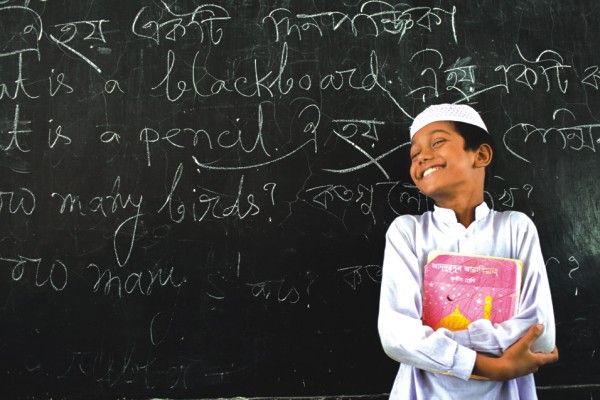
Slates, Smiles and Ambitions
Saad Adnan Khan
Photos: Kazi Tahsin Agaz Apurbo
Murshid is an expert at navigating a trawler boat through channels of ponds in the gher (fishery). He can stand and balance himself perfectly on the otherwise dangerously swaying boat. He fights with his cousin to grab the fishing net to catch fish, standing on low foothills. Other times, he likes playing cricket with friends. Murshid Morol had appeared for his Alim exams (equivalent to HSC exams) a few months back, from Baghdiya Alim Madrasah, in his village called Digraj in Bagerhat. When I asked him about his future plans, he said that he wants to study Islamic History, which I found quite interesting. I poked him a little more with questions regarding his school and classes, and in the process ended up asking some silly questions too (“Do you talk to girls?” to which he replied “Yes”). He answered rather suavely, “We don't only memorise surahs, we also have to analyse them. We have to do translations. I went to a co-ed, where boys and girls sat in the same room, and all of us had to be attired accordingly. But I feel that madrasah students struggle with English grammar the most.”
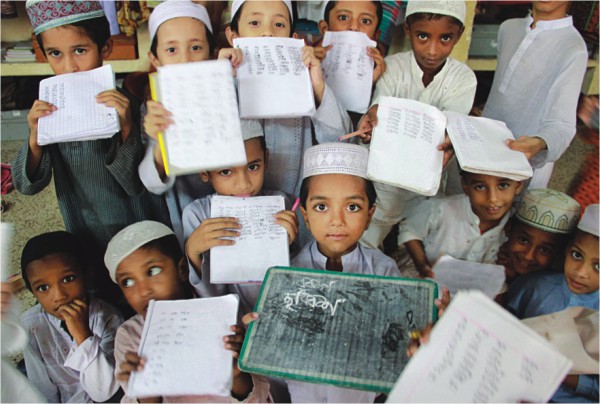
Students of the Noorani (Elementary) level, who study English, Bengali and Arabic.
| |
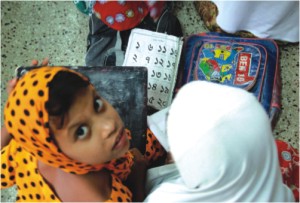 |
| |
Elementary students attending a Math class. |
Many out there, including myself, know very little about the third stream of education in the country. Most have notions about madrasah and madrasah students based on what other people tell them. It's not unusual to come across negative remarks regarding how the madrasah students are 'backward' and not very 'modern,' and how their education is devoid of creativity. Incidentally, most of us had the taste of the madrasah upbringing one way or the other. Growing up in a muslim-dominated country, at one point in our lives, many of us have been tutored by a hujoor or a religious teacher, who would visit our home in the weekend mornings and would teach us to recite the verses in the Quran. We stayed stuck in the liminal system for some time: Bengali/ English medium education in school during the weekdays and Arabic education at home during the weekends. Even then, the madrasah world is clearly separated from us by some sort of visibly invisible demarcating line. Whether it is due to language or socio-economic status or cultural contexts -- the reasons need exploring. But more importantly, the system itself needs exploring, understanding, embracing and also improving.
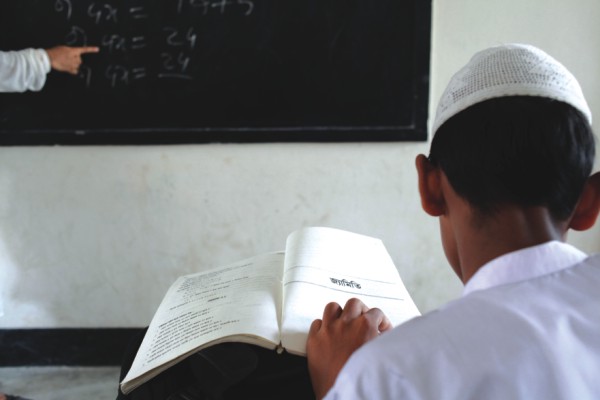
All subjects, along with Arabic, should be given equal priority in madrasahs.
The recent controversy, regarding the barring of madrasah students from being admitted to the undergraduate programmes like English, Economics, International Relations, Public Administration and Women and Gender Studies in Dhaka University (DU), despite ranking high in admissions tests, has stirred debates. The reason employed is that the marks distribution in Dakhil (SSC equivalent) and Alim English and Bengali exams is 100 each, and not 200 like mainstream secondary exams. The standard and quality of English and Bengali taught at madrasahs is also called into question. There are people who support such an act, expounding on the eligibility requirements of DU and there are people who boldly point out that this is an act of prejudice and insensitivity, also expounding on how the madrasah students should not be the sufferers due to the system that they cannot change.
| |
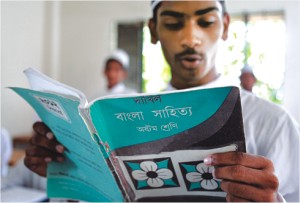 |
| |
The text books for madrasah students are published under a seperate madrasah board. |
I had questions. -- “Are you against modernism and technology?” “Do you cane children?” “Are the students well-equipped to survive in the society?”
There are mainly two types of madrasahs -- Aliya and Qoumi. Aliya madrasahs offer primary to post-graduate level mixed education, mostly private (only 3 Aliya Madrasahs are government run) and are partly funded and supervised by the government. Qoumi madrasahs offer pre-primary to post-graduate level Islamic education; they are privately funded and stand outside government control. There are about 9,300 Aliya madrasahs in Bangladesh and 94 percent of them are in the rural area (according to the findings of the project titled 'Capacity Development for Madrasa Education,' mentioned later in the article).
At the Noyatola A U N Model Kamil Madrasah, the only model madrasah in Dhaka (there are 40 model madrasahs in Bangladesh), crossing a small muddy field, we hear noises and shouts coming from classrooms nearby. Hafsa Akhter, a class 8 student wants to study Humanities in the future. She hasn't decided which subject yet, but she knows that she would want to do something for herself and her family.
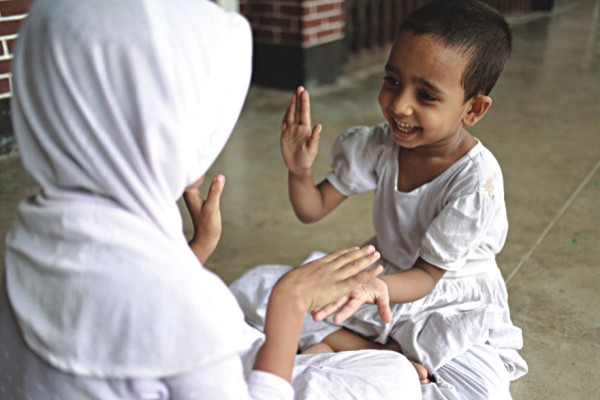
More activities should be introduced for children in madrasahs.
In another classroom, a group of students are attending their computer class, with a projector and a screen for lessons. Students of Class 10 have computer courses for Dakhil exam and younger students are given weekly computer lessons on Microsoft Office and the Internet. The former group of students, seem to be more adept at using internet applications. Quite a few of them are also on Facebook, especially the ones who are not residential students. Students in this madrasah were also involved in regular sports and annual cultural programmes. Boys and girls did classes and played sports separately, except in the Noorani (elementary) level. Madrasahs that run on low funds, however, have very different situations. There are many madrasahs that do not have good facilities for effective learning.

During recess!
It is important to point out the positive characteristics of Aliya madrasahs and also the economic impacts madrasahs have in terms of education, given the education is very affordable for general students and free for orphaned children. Madrasah students constitute a significant percentage of the total student body (about 18 percent of the whole secondary student population), and thus cannot be neglected. "The pass rate of madrasah students of Dakhil and Alim are often higher than SSC and HSC pass rate," says Harunur Rashid Khan. However, this does not necessarily reflect upon the quality of education.

Inside the dorm room of a madrasah student.
Harunur Rashid Khan, who worked as Deputy Team Leader on a project titled 'Capacity Development for Madrasah Education,' funded by Asian Development Bank, a technical assistance grant for GoB, firmly believes that the teachers at madrasahs need more training. “71 percent of the Aliya teachers are non-trained. If the teachers are not well trained, naturally the quality of education will go down. The teachers can't be sent to get a Bachelor in Education (BEd) degree in teacher training colleges, which is a one year rigorous training programme, because then there will be a shortage of teachers in the madrasahs. Bangladeseh Madrasah Teachers Training Institute in Gazipur has to be made stronger in this regard. However, Independent Ibtedaye (primary) level is in the most miserable condition. There are about 4,200 Independent madrasahs with around 6,50,000 students. Deplorably, either the Ministry of Education or the Ministry of Primary and Mass Education does not take the full responsibility of this section of madrasahs, despite the fact that providing basic education to the children is a constitutional right." Since most madrasahs are in the rural areas, it is also difficult to monitor them by one madrasah board (which is in Dhaka), adds Khan.

More computer lessons are being introduced in madrasahs.
One improvement that will happen soon is the adjustment of the Dakhil and Alim exam mark scheme with that of the SSC and HSC exams, so that students do not face obstacles while getting into an undergraduate programme. “Bengali and English exams in the Dakhil level will be out of 200 marks each from 2013. The total marks then will come to stand at 1400 of Dakhil exams, while SSC exams at 1200. This change will be brought in Alim exams too in the future. We have also submitted a proposal to start a commerce course (Madrasah education has Arts and Science subjects only) to the ministry. We are waiting for them to get back to us about this,” says Shaikh Abu Zafar Ahmad, Curriculum Specialist of Bangladesh (Aliya) Madrasah Education Board.

Learning a foreign language increases intellect.
“Anyone who studies language is believed to be intellectually sharper, and madrasah students study three languages. Of course, there is room for improvement. Madrasahs in West Bengal and Indonesia provide many different facilities that are absent here. Over there, there is a scope for more training for teachers. Students have more leadership skills too. We can bring in ideas from there and incorporate them into our system,” says Md Shafiul Muz Nabeen, Inspector of Bangladesh (Aliya) Madrasah Education Board.
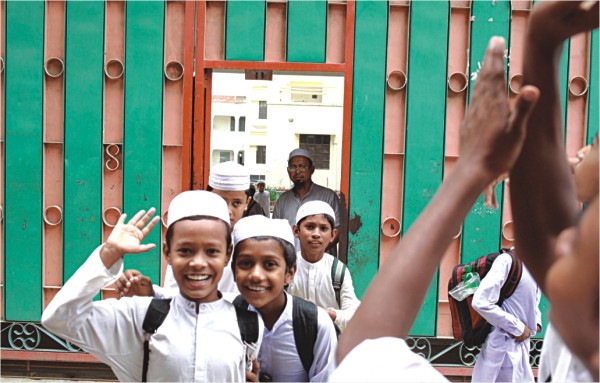
A proper plan is needed to train, monitor and facilitate teachers and students in madrasahs.
3:30 pm, a rainy afternoon. Photographer Apurbo and I walk inside a huge room of the same madrasah, where children of ages 4-5 are being taught to write numbers in Bengali words. Some of them hold slates, some notebooks, and all of them are hysterical to take pictures. In the other half of the room, orphaned children sleep on their mattress after day long classes. Girls in scarves and boys in their toopi, carry books on English, Bengali and Arabic alphabets, with colourful pictures. It's easy to say that the quality of education here is not up to the mark, but what is more important and urgent is a plan to come up with strategies and guidelines to train, monitor and facilitate teachers and students in madrasahs, so that their education is not considered any less worthy.
|
